By Marc Venema
 [1]
[1]TRENTON, Ont. (11/05/2012) Pilots work inside the cockpit of the 17th and final CC-130J upon its arrival to CFB Trenton on Friday. The first CC-130J, aircraft 601, arrived in June of 2010. Photo by Marc Venema.
A puff of smoke rolling off the tires of aircraft 617 landing at CFB Trenton last week officially marked the completion of Canada’s newest fleet of aircrafts.
The 17th and final CC-130J Hercules touched down Friday afternoon, just under two years after the first arrived.
Lieutenant-General André Deschamps, commander of the Royal Canadian Force, called the feat a dream come true.
“When I was a pilot on the legacy CC-130s, we used to dream of days like this,” Deschamps said. “Now I can proudly say those dreams have become a reality. The J-model family is complete.”
Plans to purchase the fleet were announced in 2006. The contract for 17 aircrafts was awarded to Lockheed-Martin with a price tag of US$1.4 billion. The first two aircrafts, 601 and 602, arrived in June of 2010, six months ahead of schedule. The final aircraft to arrive this past week was also ahead of schedule and on budget according to a RCAF press release.
Like its predecessor, the CC-130J is known as the “workhorse” of the Royal Canadian Air Force (RCAF).
“The Herc fleet has always been the backbone of our tactical transport,” Deschamps said.
He said the plane is very modernized compared to Hercules of the past, but is still a workhorse.
“It’s still very rugged,” Deschamps said. “That’s what you need with these tactical airplanes.”
“They have to be tough, and this airplane is tough.”
Captain Ian Wright, Aircraft Commander on the CC-130J has been a pilot for 12 years, spending the past five years flying Hercules.
“It’s my favourite plane so far that I’ve flown in the Canadian forces and my aviation career,” Wright said. “It’s pilot friendly, everything is within reach, and it’s a small tightknit crew.
“As a pilot, it allows me to have more control over every system in the plane within easy arm reach of me.”
Before the new model, Wright flew the H-model Hercules. There are currently 13 H-models in operation, ranging in age from 10-39. The other model Hercules still flying are the E-models. There are still three flying, ranging in age from 44-48. With the addition of the 17 new J-models, the RCAF currently operates 33 Hercules aircrafts.
The fleet is primarily used for tactical airlift, tactical air-to-air refueling, and fixed-wing search and rescue.
“We are the trash haulers of the air force,” Wright said. “We move people and supplies wherever they need to go.”
Wright said for a larger aircraft, the J is very responsive.
“For a large style cargo plane, you can really whip it around if required.”
In its short career, the aircraft has been involved with missions across the country, including evacuating Canadians from forest fire areas last summer.
“In less than two years since the first CC-130J was delivered, they have literally spanned the country and the globe in support of Canadian Forces operations,” said Julian Fantino, associate minister of National Defence.
In years past, Hercules aircrafts have been involved in missions not only across the country, but also around the world. They were involved in missions to Afghanistan to assist in the international campaign against terrorism. They were also used to assist the aid effort in Haiti after the earthquake.
Since the first CC-130J arrived in June of 2010, the fleet has logged more than 5,800 hours of flight time.